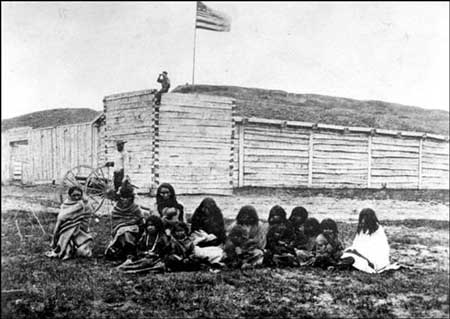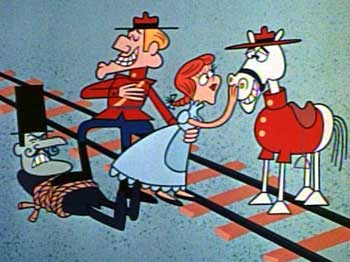The Canadian strategy in Afghanistan has been of mixed reviews. The thought of a peaceful development has led to the perception that Canadians aren't experienced in counter insurgency tactics.
The reality is also different than perceptions, Canada's history has prime examples of tactics that are being used in Afghanistan today.

Just 300 paramilitary policeman known as the North West Mounted Police moved West and in 4 months made the trek from Manitoba to the Rockies. Over 27 000 natives of different tribes and from different factions occupied a space the size of France and Germany combined. The American Indian wars had the effect of radicalizing the western tribes and it was soon realized that war was imminent. Canada avoided the coming conflict by treating the natives in a fair manner and used diplomacy in a way unseen in the West.
 |
| Fort Whoopup |
In 1876 the Sioux Nation fought the 7th Calvary in the legendary battle killing Col George Custer and his men in a hotly contested battle on little Big Horn. Over 6000 Sioux warriors and families escaped to Canada and there was a grave concern that they would bring their war like manner to the Canadian natives. The NWMP sent Superintendent Walsh and a handful of constables to ensure that the new arrivals would follow Canadian (aka British) law. The Sioux under chief Sitting Bull followed the Canadian rules but eventually returned to the US and handed over their weapons and went to the reservations that were set aside for them in 1881. Sitting Bull even went on tour with Wild Bill's Wild West Show in which he played himself.

"If the Police had not come to the country, where would we all be now? Bad men and whiskey were killing us so fast that very few, indeed, of us would have been left today. The Police have protected us as the feathers of the bird protect it from the frosts of winter. I wish them all good, and trust that all our hearts will increase in goodness from this time forward. I am satisfied. I will sign the treaty.”
(Blackfoot Nation Chief Crowfoot on signing the treaty with the crown in 1877)
Fast forward to a Canadian involvement in a foreign land with tribes of different allegiances and ethnicity. Afghanistan of today is in many ways very much like the West of North America. We see the Americans using the methods of the past in trying to pacify a people that reject foreign influence and rules of law. Canadian soldiers, politicians, diplomats and foreign affairs have tried to use the same approach as the Americans with limited and very mixed results.
The death of senior diplomat Glyn Berry led to foreign affairs almost leaving the country for a full year (2006) and the concept of the 3 block war also known as 3 D was mortally wounded. The 3 block war is an American marine invention and follows the idea that on three different blocks you could have three different activities taking place. Defence, Development and Diplomacy and if they aren't ready to handle all three situations then the native population would revolt. We see this in Kandahar today. When we don't have all three elements in place then the local population will not support a foreign war investment. People of Kandahar city sometimes don't see the need for foreign troops when they can't have electricity on a reliable basis or clean water for their children.
There is a small district in Kandahar province that is defying these very odds. The elders were never comrades to the Taliban and were generally left out of government agreements and construction during that period. This led to them being very likable to the foreign forces when the decision was to move heavily into Kandahar province in the summer of 2005. D'and district has been considered a model village by many and by others as an unworkable model based on their history and their close allegiance to the current government and foreign entities. Canadian Brig General Johnathon Vance likes to showcase D'and as an area of what Southern Afghanistan could look like.
 |
| Petraeus and Vance |
Canadian troops have tried to build Forward Operating Bases and working with police substations across the Argahndab and Panjawaii Districts. This has been of limited success as the Canadians have often said that there are not enough troops to clear the Talib and foreign fighters from the region. NATO and American forces are spread thin and the local forces the (ANA and the ANP) are unable to secure the area. This is much like on native reserves today (I.E. Hobbema) there is a lack of resources, policing and development to ensure that the populace does not live in third world conditions.
In Afghanistan we see a country that is third from the bottom of 232 countries in life expectancy and development. That isn't quite the whole picture it is also of note that they used to be in last place. That security and development in the North, East and the Capital is going at a much quicker and more successful manner than the south.
How can we use the Canadian methodology of counter insurgency to succeed in Afghanistan?
We see native reserves in Canada as models of successful development and populations that are very satisfied in their leadership and in the country. There are also many reserves that are in very poor condition and by world standards are considered to be third world in development, local government and in policing.
The people of RC South in Afghanistan need to realize that globalization and the development that follows it are an unstoppable force. The GDP of Afghanistan has risen from a low in 2001 of $2.5 billion to a max this year of $29 billion. Security in Central Asia is the focus of many player not only in the region like India, Pakistan, China and Russia but it is also the focus of such faraway countries like Norway and Canada.
Canadian counter insurgency tactics that utilized a small force can work if the will of the government and the people are behind it. We have seen a lacklustre support in the war in Afghanistan. If we are to deploy our troops into future wars and reconstruction the government and the people need to support all parts of the mission. This is not blind support but like the people of Central Canada did in the 1870's they stood behind the NWMP and their move west. The government treated some natives (like the Blackfoot Confederacy) in a fair manner and put in place a far treaty that the natives could live with. They then followed that support up with commerce that allowed small outposts that only knew of illegal drug trade to prosper and become the showcase of development in Western Canada. There are many reserves that do not follow this model and still need strong government support for such things as policing and development and that could arguably be caused by the lack of political will by all members of the government and the Canadian public.
Calgary is an example of what Kandahar could be in just 100 years, we just need to work with the old strategy of defence, development and diplomacy.
There are other places in Canada that are also examples of what Kandahar is today.

Do we have the strength of character to solve the problems here at home and in Central Asia?





No comments:
Post a Comment